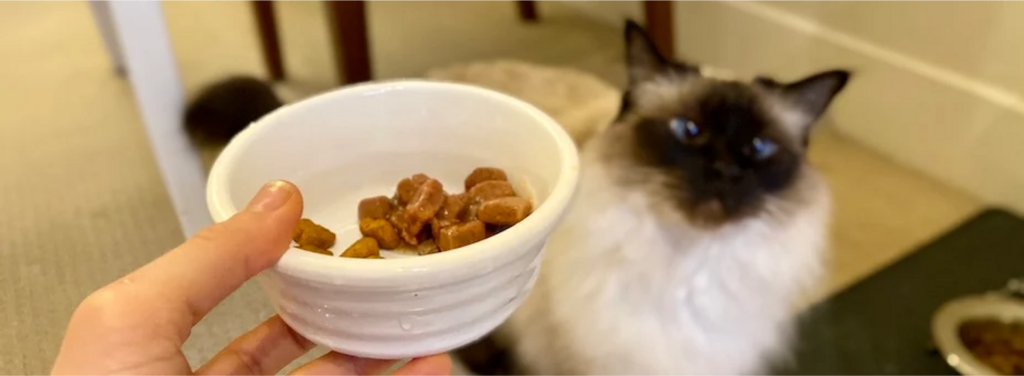Last Updated: 29/05/2025
Pet Feeding Guide
Often wondered how much to feed your pet and when? Learn how to feed the right amount.
Author: Dr Carla Paszkowski BVSc (Hons)
Reading Time: 14 minutes - short read
Ensuring your pet receives the right amount of food is crucial for their overall health and well-being. Overfeeding, a common mistake, can lead to obesity, a serious health concern for both cats and dogs.
To take the guesswork out of portioning, our comprehensive Pet Feeding Guide offers personalized recommendations based on your pet's specific needs. By following the guidelines, you can ensure your furry friend receives the optimal nutrition for a healthy and happy life.
How often to feed your pet

Your pet's lifestage and other individual factors can influence the number of times they need to be fed each day.
Puppies and kittens
Juvenile pets need to be fed more frequently than adult pets. Up until the age of about 5 to 6 months, puppies and kittens should be fed 3 meals per day - ideally splitting their daily recommended food allowance equally into thirds.
From the age of 5 or 6 months until they reach adulthood, puppies and kittens can be fed 2 meals per day. This can be achieved by halving the daily recommended feeding amount and feeding one half in the morning and one half in the evening.
Adults and seniors
Adult pets (including seniors) over the age of 12 months can be fed either once or twice daily, depending on your preference. Most people prefer to feed their pet twice daily as it fits in with their own schedule. Whichever frequency you choose, make sure to evenly split the daily feeding amount accordingly.
What about treats? Treats and dental chews are fine to give separate to meals, but should be accounted for in your dog's daily recommended feeding amount.
For more information about feeding puppies and kittens, see our New Puppy Guide and New Kitten Guide.
How much to feed your pet

Determining how much food you should feed your pet is easier than you might think, although it does depend on what you're feeding your pet and how active they are. We've broken it down based on what type of diet you currently feed your pet - one dry or wet food, a mixture of dry or wet foods, or some home cooked or meat ingredients.
If you feed one sole dry or wet food
This one is easy! If you're currently feeding one dry food OR one wet food as your pet's sole diet, simply stick to the feeding guidelines included on the packaging. Every manufacturer will print feeding guideline tables on the packet, but if you aren't sure, you can also consult their website. Please note that feeding guidelines are guides only and should be adjusted depending on your pet's body condition score.The daily feeding amount specified for your pet can be split into portions depending on how many times per day you feed your pet. If you choose to give your pet a few treats, it's important to take this into consideration with regards to their daily calorie intake. For example, one Greenies Regular dog treat contains 91 calories, so every time you feed a Greenies dog treat you'll need to reduce their daily meal by the equivalent calorie load.
If you combine different dry foods and/or wet foods
Feeding a mixture of dry and wet food has many benefits - not only does it allow your pet some variety, but it helps them reap the benefits of both. If you're feeding a mixture of two or more types of food, it's best to take the recommended daily feeding amount for each (as stipulated on the packaging) and divide them accordingly. Remember that the daily amount provided on the packaging is given under the assumption that the food is fed as the sole diet - so when combining two diets, divide this suggested amount. A good ratio to work off is to give a majority of dry food - for instance, feed 2/3rds of the recommended daily dry food amount and 1/3rd of the recommended wet food amount.
If you feed home cooked food or extra meat
Many pet parents choose to incorporate home cooked food and extra meat into their pet's diet. Obviously meat and other wholefood ingredients don't come with a daily feeding guideline, so in order to figure out how much you should feed, you'll have to do the maths yourself.
How much meat should you feed your dog or cat? Rest assured that if you choose a premium, balanced diet, there's no need to supplement your pet's diet with extra meat or vegetables. Premium diets contain everything your pet needs. But if you'd like to provide some extra ingredients, we recommend keeping a balanced pet food as at least 80% of the daily calories and including no more than 20% of the daily calories as extra meat. For puppies, we recommend even less - no more than 10% of the total daily calories.
Calculating your pet's daily feeding amount

Determining your pet's daily calorie requirement is important when mixing foods or accounting for extra meat and treats to avoid overfeeding. But it's vital to understand that daily calorie requirement is only part of the equation if you're creating a home cooked diet, as it doesn't take into account macro or micronutrients such as protein, carbohydrates, fat, or vitamins and minerals. Therefore, if you're attempting to create a balanced, home-cooked diet, we suggest consulting with a veterinary nutritionist for further advice.
The first step is to determine your pet's resting energy requirement (RER), then use this figure to determine their daily energy requirement (DER). RER represents the energy requirement of your pet while at rest at a controlled temperature.
To determine RER, you can use the formula RER = 70 x (body weight in kg)0.75
The next step is to take your pet's lifestage and body condition into account by calculating their Daily Energy Requirement (DER). DER is found by multiplying your pet's RER by a coefficient (a) based on their life stage, activity, and body condition, in the following formula: DER = a x RER
Common coefficients (values for 'a') are listed below:
NB These figures are a guide only and should be checked with your vet.
Dogs and puppies
- Up to 4 months: 3 x RER
- 4 to 12 months: 2 x RER
- Desexed adult: 1.6 x RER
- Intact adult: 1.8 x RER
- Weight loss: 1 x RER
- Overweight prone or inactive: 1.2 x RER
- Highly active: 2-5 x RER
- Gestation: 1.6 - 2.0 x RER
- Lactation: 2 - 6 RER
Cats and kittens
- Up to 4 months: 2.5 x RER
- 4 to 12 months: 2.5 x RER
- Desexed adult: 1.2 x RER
- Intact adult: 1.4 x RER
- Weight loss: 0.8 x RER
- Overweight prone or inactive: 1 x RER
- Highly active: 2 x RER
- Gestation: 2 - 3 x RER
- Lactation: 2 - 6 RER
Need help calculating how much you should be feeding your pet? Request a free Vet Pet Plan for tailored nutrition, health and behavioural advice.
History
Our experts continually monitor the health and wellness space and we update our articles when new information becomes available.
Fri Feb 14 2025
Edited by Dr Teagan Lever BVSc (Hons)Dr Carla Paszkowski BVSc (Hons)
Veterinarian
Dr. Carla graduated from the University of Queensland in 2013 with a Bachelor of Veterinary Science and worked for a number of years in small animal clinics across South East Queensland. While Carla enjoys most facets of clinical veterinary work, she holds a special passion for feline medicine, pocket pets, and nutrition.

